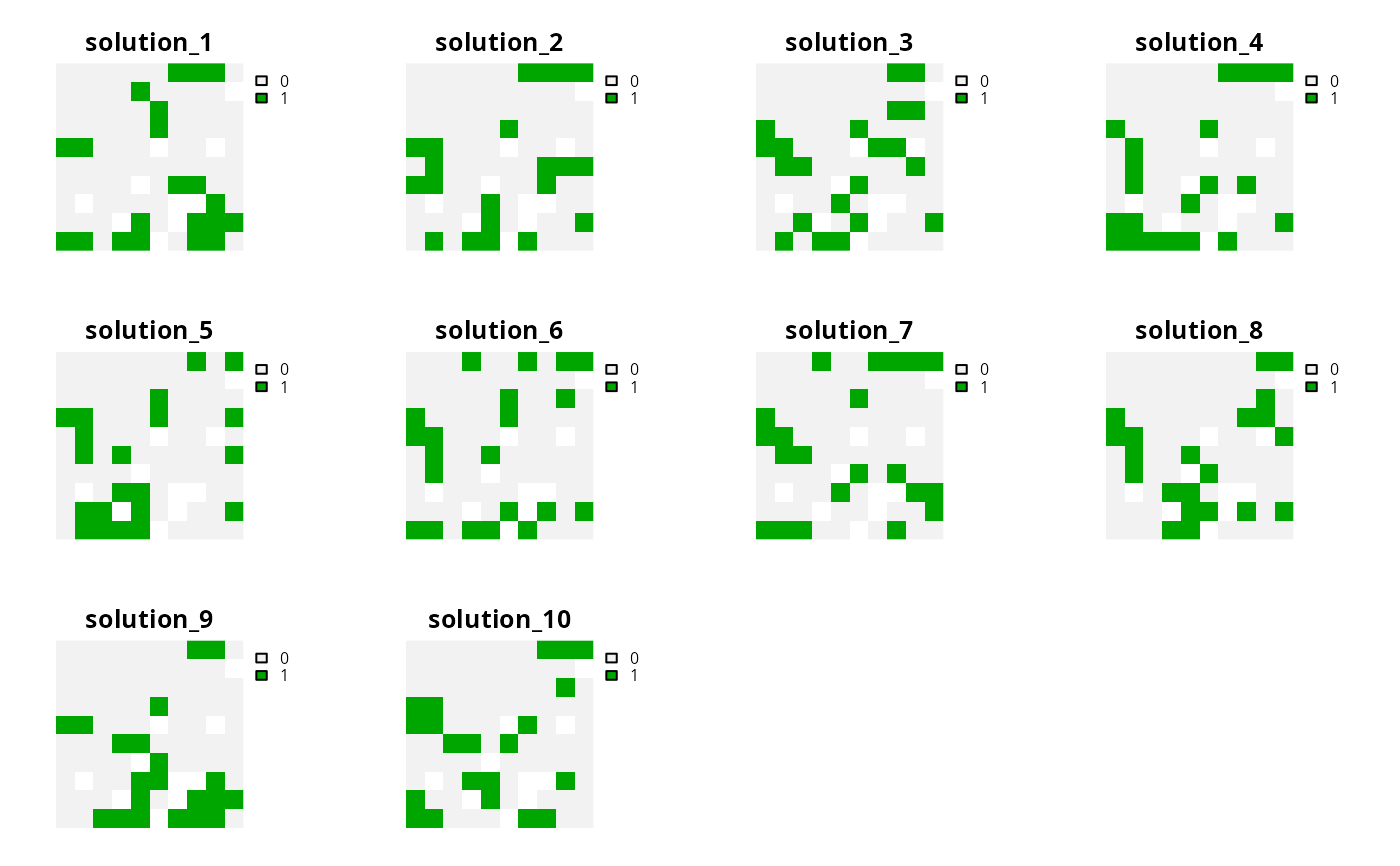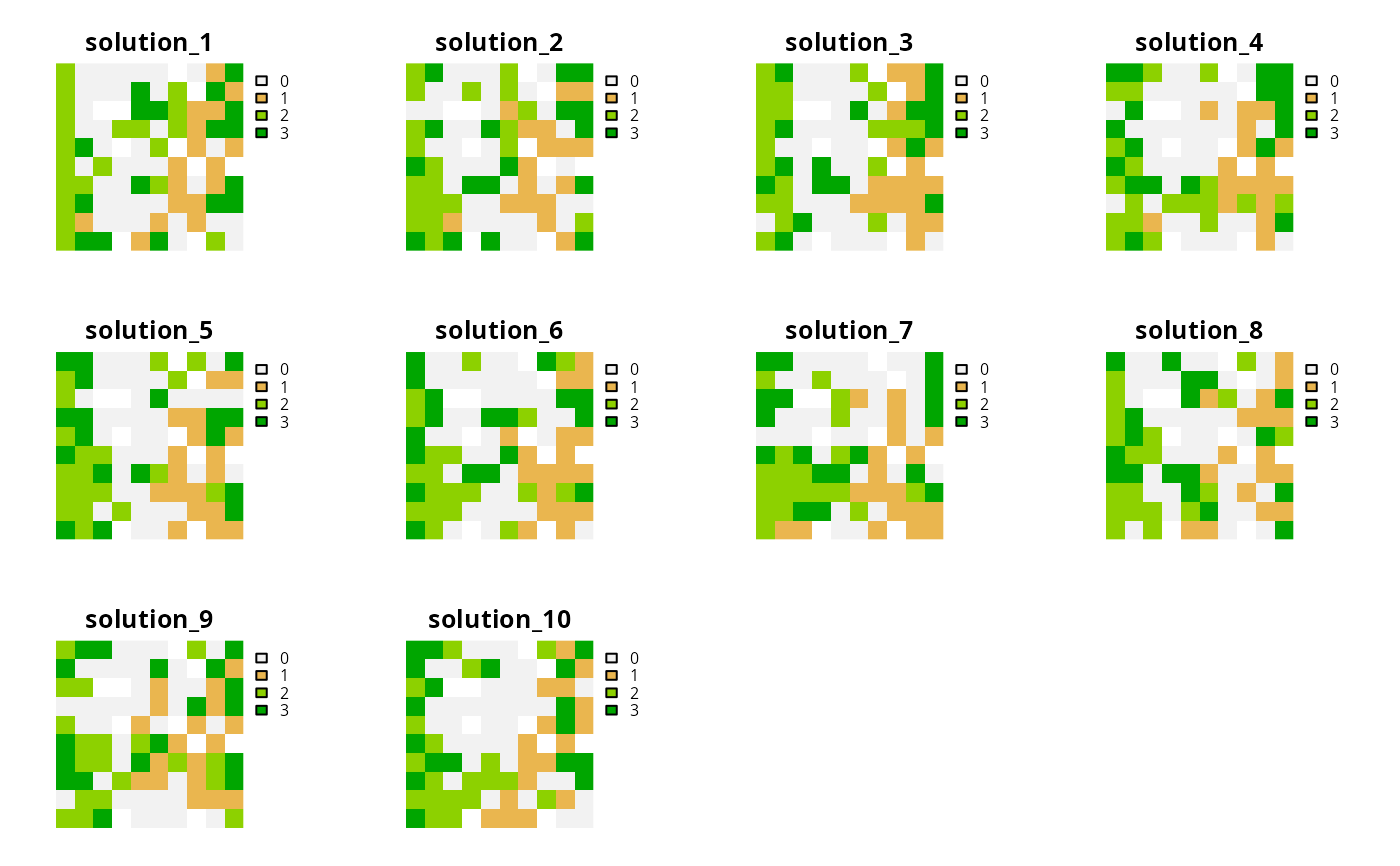Generate a portfolio of solutions for a conservation planning problem by randomly reordering the data prior to solving the problem. Although this function can be useful for generating multiple different solutions for a given problem, it is recommended to use add_pool_portfolio if the Gurobi software is available.
Arguments
- x
problem()object.- number_solutions
integernumber of attempts to generate different solutions. Defaults to 10.- threads
integernumber of threads to use for the generating the solution portfolio. Defaults to 1.- remove_duplicates
logicalshould duplicate solutions be removed? Defaults toTRUE.
Value
An updated problem() object with the portfolio added to it.
Details
This strategy for generating a portfolio of solutions often results in different solutions, depending on optimality gap, but may return duplicate solutions. In general, this strategy is most effective when problems are quick to solve and multiple threads are available for solving each problem separately.
See also
See portfolios for an overview of all functions for adding a portfolio.
Other functions for adding portfolios:
add_cuts_portfolio(),
add_default_portfolio(),
add_extra_portfolio(),
add_gap_portfolio(),
add_top_portfolio()
Examples
# \dontrun{
# set seed for reproducibility
set.seed(500)
# load data
sim_pu_raster <- get_sim_pu_raster()
sim_features <- get_sim_features()
sim_zones_pu_raster <- get_sim_zones_pu_raster()
sim_zones_features <- get_sim_zones_features()
# create minimal problem with shuffle portfolio
p1 <-
problem(sim_pu_raster, sim_features) %>%
add_min_set_objective() %>%
add_relative_targets(0.2) %>%
add_shuffle_portfolio(10, remove_duplicates = FALSE) %>%
add_default_solver(gap = 0.2, verbose = FALSE)
# solve problem and generate 10 solutions within 20% of optimality
s1 <- solve(p1)
# convert portfolio into a multi-layer raster
s1 <- terra::rast(s1)
# print number of solutions found
print(terra::nlyr(s1))
#> [1] 10
# plot solutions in portfolio
plot(s1, axes = FALSE)
 # build multi-zone conservation problem with shuffle portfolio
p2 <-
problem(sim_zones_pu_raster, sim_zones_features) %>%
add_min_set_objective() %>%
add_relative_targets(matrix(runif(15, 0.1, 0.2), nrow = 5, ncol = 3)) %>%
add_binary_decisions() %>%
add_shuffle_portfolio(10, remove_duplicates = FALSE) %>%
add_default_solver(gap = 0.2, verbose = FALSE)
# solve the problem
s2 <- solve(p2)
# convert each solution in the portfolio into a single category layer
s2 <- terra::rast(lapply(s2, category_layer))
# print number of solutions found
print(terra::nlyr(s2))
#> [1] 10
# plot solutions in portfolio
plot(s2, axes = FALSE)
# build multi-zone conservation problem with shuffle portfolio
p2 <-
problem(sim_zones_pu_raster, sim_zones_features) %>%
add_min_set_objective() %>%
add_relative_targets(matrix(runif(15, 0.1, 0.2), nrow = 5, ncol = 3)) %>%
add_binary_decisions() %>%
add_shuffle_portfolio(10, remove_duplicates = FALSE) %>%
add_default_solver(gap = 0.2, verbose = FALSE)
# solve the problem
s2 <- solve(p2)
# convert each solution in the portfolio into a single category layer
s2 <- terra::rast(lapply(s2, category_layer))
# print number of solutions found
print(terra::nlyr(s2))
#> [1] 10
# plot solutions in portfolio
plot(s2, axes = FALSE)
 # }
# }
